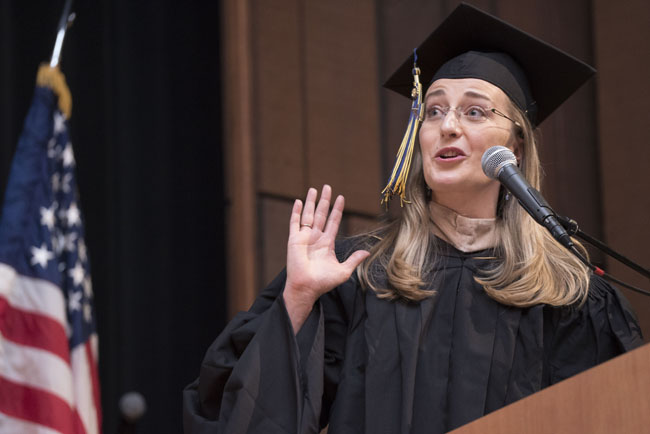A tribe can be described in many ways. Socially, it could refer to a community bound by customs and traditions. In a tribe, people hold similar aspirations and values, which enables them to intimately understand and support each other. Laura Adint defines tribe as her cohort of classmates in the MBA for Executives program at Berkeley Haas. In two short years, they became her family.
On January 24, Adint and 67 members of her tribe were the first to graduate from Haas’ burgeoning EMBA program. The program began in 2013 after Haas and Columbia Business School discontinued their joint EMBA program.
Adint, who graduated as the program’s inaugural valedictorian, has always enjoyed her work. She wanted to do her job well, manage interesting projects, and develop as a professional. She worked for organizations like Ford Motor Company, Xilinx and Kelly OCG. Based on all the Linkedin recommendations she’s received from colleagues, she has definitely earned their trust and respect.
A C-SUITE ‘CREDENTIALING’
Still, Adint wanted more. Specifically, a position in a C-Suite. So she did what many aspiring executives do: She started combing the websites of some of her favorite companies, looking at the bios of COOs. She noticed the majority had something in common—they all had MBAs. Adint calls it “credentialing” and decided she wanted one, too. Unlike the stereotypical full-time MBA student, Adint is not a 20-something. She is a 30-something. And a mom. And she wanted a tribe that could relate to that. The EMBA seemed more likely to provide that community.
Next, she needed to decide on a school. She knew she didn’t want to fly around the country (or world) just to attend class, so the South Bay Area resident focused on nearby Wharton’s San Francisco campus, Santa Clara and Berkeley’s Haas. Like any adept consultant, Adint created a spreadsheet of potential schools. As Adint describes it, it had “many, many columns.” Location, program focus, where their graduates went to work, everything.
Her husband had completed the full-time traditional MBA at Berkeley Haas a few years prior. Adint remembered how she loved interacting with her husband’s classmates. She also knew of the prestige of a Haas degree and alumni network that came with it. Based on those relationships, and a general management curriculum (with a slight consulting lean), Haas rose to the top. In the end, it was the only school she applied to.
“I didn’t think I would be able to relate to the ages of students my husband went to school with,” Adint says. “But I knew I liked them. I just knew where I was in my life was different from where his classmates were in life when he went through the program. I didn’t want to start over. I liked my job and career path.”
‘HAASHOLES’ NO MORE
Once in the program, an early experience set the tone for Adint’s quest for an EMBA.
“I expected everyone to be really smart,” Adint says. “And they were. What I didn’t expect was how non-competitive everyone was.”
Adint felt perfectly at home in the program’s core statistics course, Data and Decisions. She was a math major in undergrad, after all. She also knew mathematics and engineering majors tended to be very driven and competitive.
“For our first exam, we got to take one page of notes into the room with us,” says Adint. “They are very important to the individual. I walked in and some had photocopied their notes and were handing them out to classmates as they walked in the door. I was not expecting that collaboration.”
Adint describes the program as very practical in the sense she often learned just as much from her classmates and their experiences as she did the professors.
“We all get better together,” Ardint says. “You help people out and you learn from others.”






Questions about this article? Email us or leave a comment below.